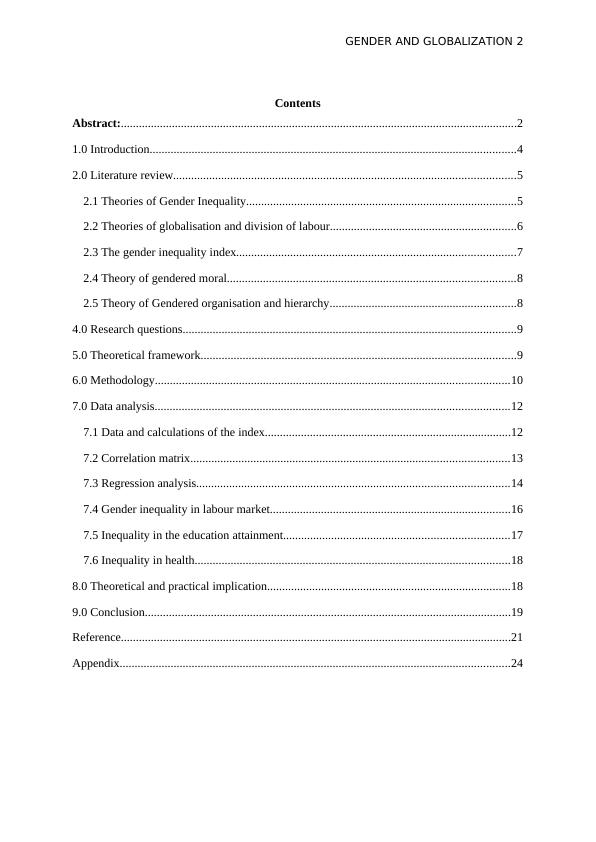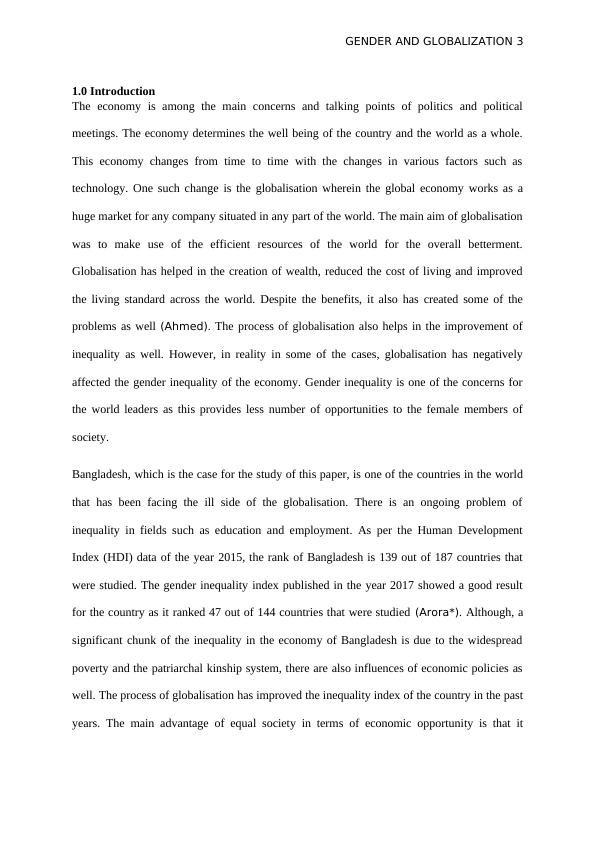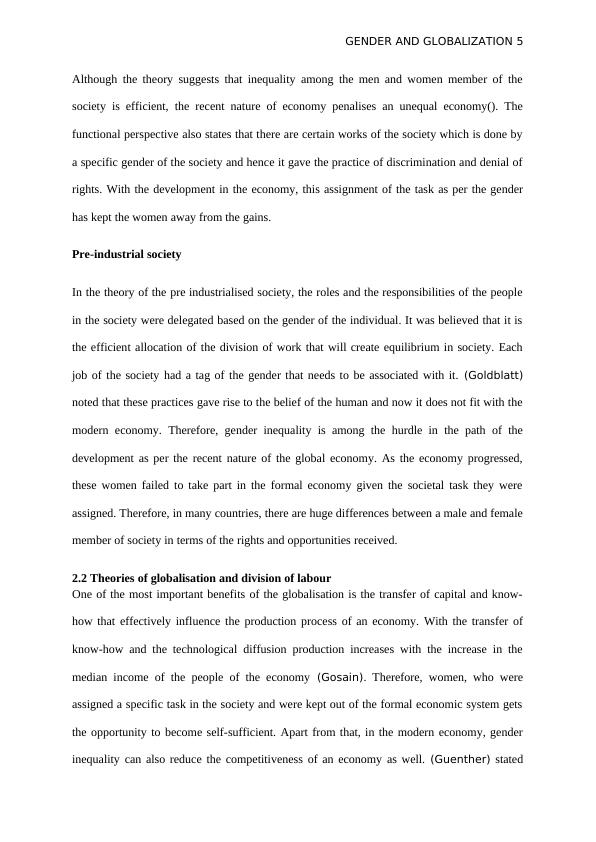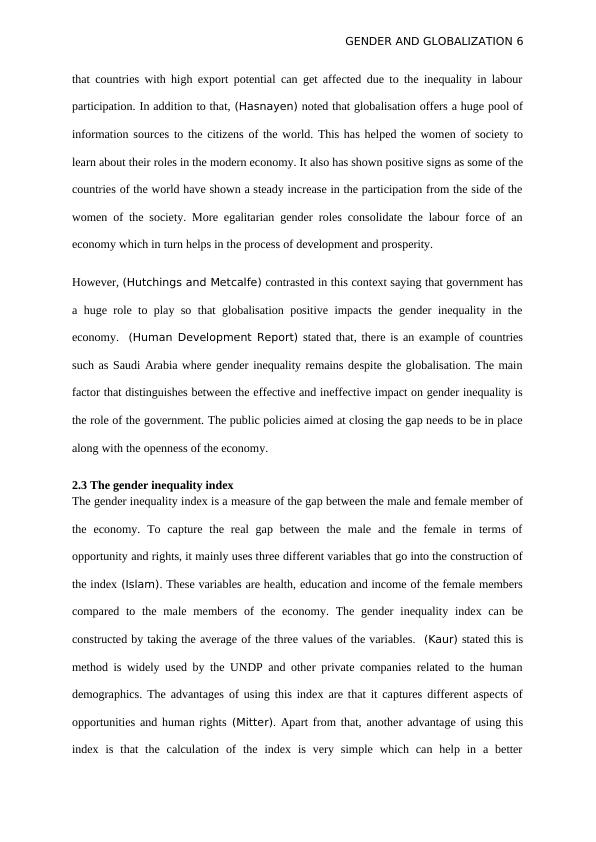Gender and Globalization: Impact on Bangladesh Gender Inequalities
Repair and polish a research paper on the impact of trade liberalization on gender inequality in Bangladesh, using Bangladesh-related data, analysis, and citations.
29 Pages6945 Words305 Views
Added on 2022-11-17
About This Document
This paper explores the impact of trade liberalization on gender inequalities in Bangladesh. It analyzes the three dimensions of global gender inequality using UNDP, WHO, GDP, IHDI and HII data from 1990 to 2017. The study investigates the influence of liberalization on gender inequality in Bangladesh, using proxy variables for economic opportunity, health, and education.
Gender and Globalization: Impact on Bangladesh Gender Inequalities
Repair and polish a research paper on the impact of trade liberalization on gender inequality in Bangladesh, using Bangladesh-related data, analysis, and citations.
Added on 2022-11-17
ShareRelated Documents
GENDER AND GLOBALIZATION 1
Abstract:
In our paper, we will discuss the case study of Bangladesh. This main study focus is
to explore the trade liberalization impact on Bangladesh gender inequalities. The basis of
global gender inequality is these three dimensions, containing education, health facilities, and
the labour market are analyzed using UNDP, WHO, GDP, IHDI and HII data (1990 to 2017)
for Bangladesh. We will use other market indicators to construct the gender inequality index
rather than directly using wage differences of gender due to data limitation in Bangladesh.
We will leverage the UNDP introduced a GDI sensitive weighting formula that expresses a
moderate aversion to inequality equal to two (2) that is a harmonic mean of the male and
female values that we will be using in a similar methodology to form the time GDI variant.
Besides, imports and exports to per-capita gross domestic product or GDP, GDP ratio, and
school ratio of a number of girls to the number of boys are recognized as essential factors of
overall Bangladesh gender inequality and in Bangladesh labour market gender inequality.
Additionally, in the attainment of education gender inequality, also we will go through
Bangladesh’s per-capita GDP, school ratio of a number of girls to the number of boys’
schools and per school number of female teachers.
Keywords: Globalization, Gender, inequality, labour market, liberalization
Abstract:
In our paper, we will discuss the case study of Bangladesh. This main study focus is
to explore the trade liberalization impact on Bangladesh gender inequalities. The basis of
global gender inequality is these three dimensions, containing education, health facilities, and
the labour market are analyzed using UNDP, WHO, GDP, IHDI and HII data (1990 to 2017)
for Bangladesh. We will use other market indicators to construct the gender inequality index
rather than directly using wage differences of gender due to data limitation in Bangladesh.
We will leverage the UNDP introduced a GDI sensitive weighting formula that expresses a
moderate aversion to inequality equal to two (2) that is a harmonic mean of the male and
female values that we will be using in a similar methodology to form the time GDI variant.
Besides, imports and exports to per-capita gross domestic product or GDP, GDP ratio, and
school ratio of a number of girls to the number of boys are recognized as essential factors of
overall Bangladesh gender inequality and in Bangladesh labour market gender inequality.
Additionally, in the attainment of education gender inequality, also we will go through
Bangladesh’s per-capita GDP, school ratio of a number of girls to the number of boys’
schools and per school number of female teachers.
Keywords: Globalization, Gender, inequality, labour market, liberalization

GENDER AND GLOBALIZATION 2
Contents
Abstract:....................................................................................................................................2
1.0 Introduction..........................................................................................................................4
2.0 Literature review..................................................................................................................5
2.1 Theories of Gender Inequality..........................................................................................5
2.2 Theories of globalisation and division of labour..............................................................6
2.3 The gender inequality index.............................................................................................7
2.4 Theory of gendered moral................................................................................................8
2.5 Theory of Gendered organisation and hierarchy..............................................................8
4.0 Research questions...............................................................................................................9
5.0 Theoretical framework.........................................................................................................9
6.0 Methodology......................................................................................................................10
7.0 Data analysis......................................................................................................................12
7.1 Data and calculations of the index..................................................................................12
7.2 Correlation matrix..........................................................................................................13
7.3 Regression analysis........................................................................................................14
7.4 Gender inequality in labour market................................................................................16
7.5 Inequality in the education attainment...........................................................................17
7.6 Inequality in health.........................................................................................................18
8.0 Theoretical and practical implication.................................................................................18
9.0 Conclusion..........................................................................................................................19
Reference..................................................................................................................................21
Appendix..................................................................................................................................24
Contents
Abstract:....................................................................................................................................2
1.0 Introduction..........................................................................................................................4
2.0 Literature review..................................................................................................................5
2.1 Theories of Gender Inequality..........................................................................................5
2.2 Theories of globalisation and division of labour..............................................................6
2.3 The gender inequality index.............................................................................................7
2.4 Theory of gendered moral................................................................................................8
2.5 Theory of Gendered organisation and hierarchy..............................................................8
4.0 Research questions...............................................................................................................9
5.0 Theoretical framework.........................................................................................................9
6.0 Methodology......................................................................................................................10
7.0 Data analysis......................................................................................................................12
7.1 Data and calculations of the index..................................................................................12
7.2 Correlation matrix..........................................................................................................13
7.3 Regression analysis........................................................................................................14
7.4 Gender inequality in labour market................................................................................16
7.5 Inequality in the education attainment...........................................................................17
7.6 Inequality in health.........................................................................................................18
8.0 Theoretical and practical implication.................................................................................18
9.0 Conclusion..........................................................................................................................19
Reference..................................................................................................................................21
Appendix..................................................................................................................................24

GENDER AND GLOBALIZATION 3
1.0 Introduction
The economy is among the main concerns and talking points of politics and political
meetings. The economy determines the well being of the country and the world as a whole.
This economy changes from time to time with the changes in various factors such as
technology. One such change is the globalisation wherein the global economy works as a
huge market for any company situated in any part of the world. The main aim of globalisation
was to make use of the efficient resources of the world for the overall betterment.
Globalisation has helped in the creation of wealth, reduced the cost of living and improved
the living standard across the world. Despite the benefits, it also has created some of the
problems as well (Ahmed). The process of globalisation also helps in the improvement of
inequality as well. However, in reality in some of the cases, globalisation has negatively
affected the gender inequality of the economy. Gender inequality is one of the concerns for
the world leaders as this provides less number of opportunities to the female members of
society.
Bangladesh, which is the case for the study of this paper, is one of the countries in the world
that has been facing the ill side of the globalisation. There is an ongoing problem of
inequality in fields such as education and employment. As per the Human Development
Index (HDI) data of the year 2015, the rank of Bangladesh is 139 out of 187 countries that
were studied. The gender inequality index published in the year 2017 showed a good result
for the country as it ranked 47 out of 144 countries that were studied (Arora*). Although, a
significant chunk of the inequality in the economy of Bangladesh is due to the widespread
poverty and the patriarchal kinship system, there are also influences of economic policies as
well. The process of globalisation has improved the inequality index of the country in the past
years. The main advantage of equal society in terms of economic opportunity is that it
1.0 Introduction
The economy is among the main concerns and talking points of politics and political
meetings. The economy determines the well being of the country and the world as a whole.
This economy changes from time to time with the changes in various factors such as
technology. One such change is the globalisation wherein the global economy works as a
huge market for any company situated in any part of the world. The main aim of globalisation
was to make use of the efficient resources of the world for the overall betterment.
Globalisation has helped in the creation of wealth, reduced the cost of living and improved
the living standard across the world. Despite the benefits, it also has created some of the
problems as well (Ahmed). The process of globalisation also helps in the improvement of
inequality as well. However, in reality in some of the cases, globalisation has negatively
affected the gender inequality of the economy. Gender inequality is one of the concerns for
the world leaders as this provides less number of opportunities to the female members of
society.
Bangladesh, which is the case for the study of this paper, is one of the countries in the world
that has been facing the ill side of the globalisation. There is an ongoing problem of
inequality in fields such as education and employment. As per the Human Development
Index (HDI) data of the year 2015, the rank of Bangladesh is 139 out of 187 countries that
were studied. The gender inequality index published in the year 2017 showed a good result
for the country as it ranked 47 out of 144 countries that were studied (Arora*). Although, a
significant chunk of the inequality in the economy of Bangladesh is due to the widespread
poverty and the patriarchal kinship system, there are also influences of economic policies as
well. The process of globalisation has improved the inequality index of the country in the past
years. The main advantage of equal society in terms of economic opportunity is that it

GENDER AND GLOBALIZATION 4
provides a more balanced distribution of the wealth of the economy. Apart from that, better
gender equality in the economy also improves the living standard of the people as well.
The paper aims to investigate whether the globalisation does affect gender inequality in the
case of Bangladesh. The economy of Bangladesh was liberalised and opened to the global
market in the year 1997 (Baliamoune-Lutz). This paper, using the data from sources such
as IMF and World Bank will examine whether there is any influence of liberalisation on the
gender inequality in Bangladesh. Along with that, the objective of the paper also includes
finding whether the globalisation affects gender inequality in the case of Bangladesh. The
finding of this paper can be a valuable resource for the government and other private
organisations. The government can get a detailed insight from this paper which can be used
before the development of any government policy related to the gender inequality of
Bangladesh.
2.0 Literature review
2.1 Theories of Gender Inequality
According to the literature of sociology, gender inequality is the difference between men and
women members of the society in terms of economic opportunity and rights. It also
encapsulates the psychological, cultural differences between male and female members of the
society. (BenerÍa, Floro and MacDonald) stated that, it is the gender roles in the societal
that stems from the unequal treatment of the men and women in society. (CEIC) stated that,
gender inequality is the denial of opportunity and rights to the individuals based on their
gender. There are mainly two perspectives of gender inequalities, these are presented below:
The functionalist perspective
This perspective is part of sociological literature that states, entities are interdependent. It also
emphasizes on the fact that gender inequalities help in the division of labour as well.
provides a more balanced distribution of the wealth of the economy. Apart from that, better
gender equality in the economy also improves the living standard of the people as well.
The paper aims to investigate whether the globalisation does affect gender inequality in the
case of Bangladesh. The economy of Bangladesh was liberalised and opened to the global
market in the year 1997 (Baliamoune-Lutz). This paper, using the data from sources such
as IMF and World Bank will examine whether there is any influence of liberalisation on the
gender inequality in Bangladesh. Along with that, the objective of the paper also includes
finding whether the globalisation affects gender inequality in the case of Bangladesh. The
finding of this paper can be a valuable resource for the government and other private
organisations. The government can get a detailed insight from this paper which can be used
before the development of any government policy related to the gender inequality of
Bangladesh.
2.0 Literature review
2.1 Theories of Gender Inequality
According to the literature of sociology, gender inequality is the difference between men and
women members of the society in terms of economic opportunity and rights. It also
encapsulates the psychological, cultural differences between male and female members of the
society. (BenerÍa, Floro and MacDonald) stated that, it is the gender roles in the societal
that stems from the unequal treatment of the men and women in society. (CEIC) stated that,
gender inequality is the denial of opportunity and rights to the individuals based on their
gender. There are mainly two perspectives of gender inequalities, these are presented below:
The functionalist perspective
This perspective is part of sociological literature that states, entities are interdependent. It also
emphasizes on the fact that gender inequalities help in the division of labour as well.

GENDER AND GLOBALIZATION 5
Although the theory suggests that inequality among the men and women member of the
society is efficient, the recent nature of economy penalises an unequal economy(). The
functional perspective also states that there are certain works of the society which is done by
a specific gender of the society and hence it gave the practice of discrimination and denial of
rights. With the development in the economy, this assignment of the task as per the gender
has kept the women away from the gains.
Pre-industrial society
In the theory of the pre industrialised society, the roles and the responsibilities of the people
in the society were delegated based on the gender of the individual. It was believed that it is
the efficient allocation of the division of work that will create equilibrium in society. Each
job of the society had a tag of the gender that needs to be associated with it. (Goldblatt)
noted that these practices gave rise to the belief of the human and now it does not fit with the
modern economy. Therefore, gender inequality is among the hurdle in the path of the
development as per the recent nature of the global economy. As the economy progressed,
these women failed to take part in the formal economy given the societal task they were
assigned. Therefore, in many countries, there are huge differences between a male and female
member of society in terms of the rights and opportunities received.
2.2 Theories of globalisation and division of labour
One of the most important benefits of the globalisation is the transfer of capital and know-
how that effectively influence the production process of an economy. With the transfer of
know-how and the technological diffusion production increases with the increase in the
median income of the people of the economy (Gosain). Therefore, women, who were
assigned a specific task in the society and were kept out of the formal economic system gets
the opportunity to become self-sufficient. Apart from that, in the modern economy, gender
inequality can also reduce the competitiveness of an economy as well. (Guenther) stated
Although the theory suggests that inequality among the men and women member of the
society is efficient, the recent nature of economy penalises an unequal economy(). The
functional perspective also states that there are certain works of the society which is done by
a specific gender of the society and hence it gave the practice of discrimination and denial of
rights. With the development in the economy, this assignment of the task as per the gender
has kept the women away from the gains.
Pre-industrial society
In the theory of the pre industrialised society, the roles and the responsibilities of the people
in the society were delegated based on the gender of the individual. It was believed that it is
the efficient allocation of the division of work that will create equilibrium in society. Each
job of the society had a tag of the gender that needs to be associated with it. (Goldblatt)
noted that these practices gave rise to the belief of the human and now it does not fit with the
modern economy. Therefore, gender inequality is among the hurdle in the path of the
development as per the recent nature of the global economy. As the economy progressed,
these women failed to take part in the formal economy given the societal task they were
assigned. Therefore, in many countries, there are huge differences between a male and female
member of society in terms of the rights and opportunities received.
2.2 Theories of globalisation and division of labour
One of the most important benefits of the globalisation is the transfer of capital and know-
how that effectively influence the production process of an economy. With the transfer of
know-how and the technological diffusion production increases with the increase in the
median income of the people of the economy (Gosain). Therefore, women, who were
assigned a specific task in the society and were kept out of the formal economic system gets
the opportunity to become self-sufficient. Apart from that, in the modern economy, gender
inequality can also reduce the competitiveness of an economy as well. (Guenther) stated

GENDER AND GLOBALIZATION 6
that countries with high export potential can get affected due to the inequality in labour
participation. In addition to that, (Hasnayen) noted that globalisation offers a huge pool of
information sources to the citizens of the world. This has helped the women of society to
learn about their roles in the modern economy. It also has shown positive signs as some of the
countries of the world have shown a steady increase in the participation from the side of the
women of the society. More egalitarian gender roles consolidate the labour force of an
economy which in turn helps in the process of development and prosperity.
However, (Hutchings and Metcalfe) contrasted in this context saying that government has
a huge role to play so that globalisation positive impacts the gender inequality in the
economy. (Human Development Report) stated that, there is an example of countries
such as Saudi Arabia where gender inequality remains despite the globalisation. The main
factor that distinguishes between the effective and ineffective impact on gender inequality is
the role of the government. The public policies aimed at closing the gap needs to be in place
along with the openness of the economy.
2.3 The gender inequality index
The gender inequality index is a measure of the gap between the male and female member of
the economy. To capture the real gap between the male and the female in terms of
opportunity and rights, it mainly uses three different variables that go into the construction of
the index (Islam). These variables are health, education and income of the female members
compared to the male members of the economy. The gender inequality index can be
constructed by taking the average of the three values of the variables. (Kaur) stated this is
method is widely used by the UNDP and other private companies related to the human
demographics. The advantages of using this index are that it captures different aspects of
opportunities and human rights (Mitter). Apart from that, another advantage of using this
index is that the calculation of the index is very simple which can help in a better
that countries with high export potential can get affected due to the inequality in labour
participation. In addition to that, (Hasnayen) noted that globalisation offers a huge pool of
information sources to the citizens of the world. This has helped the women of society to
learn about their roles in the modern economy. It also has shown positive signs as some of the
countries of the world have shown a steady increase in the participation from the side of the
women of the society. More egalitarian gender roles consolidate the labour force of an
economy which in turn helps in the process of development and prosperity.
However, (Hutchings and Metcalfe) contrasted in this context saying that government has
a huge role to play so that globalisation positive impacts the gender inequality in the
economy. (Human Development Report) stated that, there is an example of countries
such as Saudi Arabia where gender inequality remains despite the globalisation. The main
factor that distinguishes between the effective and ineffective impact on gender inequality is
the role of the government. The public policies aimed at closing the gap needs to be in place
along with the openness of the economy.
2.3 The gender inequality index
The gender inequality index is a measure of the gap between the male and female member of
the economy. To capture the real gap between the male and the female in terms of
opportunity and rights, it mainly uses three different variables that go into the construction of
the index (Islam). These variables are health, education and income of the female members
compared to the male members of the economy. The gender inequality index can be
constructed by taking the average of the three values of the variables. (Kaur) stated this is
method is widely used by the UNDP and other private companies related to the human
demographics. The advantages of using this index are that it captures different aspects of
opportunities and human rights (Mitter). Apart from that, another advantage of using this
index is that the calculation of the index is very simple which can help in a better

End of preview
Want to access all the pages? Upload your documents or become a member.
